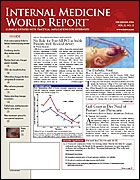Publication
Article
Internal Medicine World Report
Losing Weight Keeps Diabetes at Bay
Author(s):
Diabetes Care
Weight loss should be the primary goal of interventions aimed at reducing diabetes risk, concludes a new study of more than 1000 people (. 2006; 29:2102-2107).
The trial included participants from the Diabetes Prevention Program who had been randomized to intensive lifestyle intervention. Of the 1079 participants (aged 25-84 years; mean body mass index 33.9 kg/m2), 153 developed diabetes over the 3.2-year mean follow-up period.
On average, for every 1-kg weight loss, the risk of developing diabetes was reduced by 16%. Weight loss was found to protect against diabetes in all persons, regardless of race/ethnicity (ie, white, African American, Hispanic, Native American, Asian/ Pacific Islander), gender, age, or level of obesity at study onset.
P
P
The physical fitness goal for the study was 150 min of moderate-intensity activity every week. Meeting this goal reduced the risk of developing diabetes by 46% ( = .007). Eight subgroups were then created to assess the impact of intensive lifestyle interventions (ie, weight loss, dietary fat reduction, exercise). The group that met all the study goals reduced their risk of diabetes by 89% (?<.001).
P
Among the 495 participants who did not meet the weight-loss goal at 1 year, meeting the percent fat goal had no significant effect on diabetes incidence ( = .50). Notably, even a modest weight loss of only ?2.6 kg was independently and significantly associated with a reduced diabetes risk.?
Extrapolating these data, the investigators suggest that patients who lose 5% to 7% of their body weight and who meet physical activity and dietary fat goals could reduce their risk of developing diabetes by >90%.
"Weight loss, largely determined by changes in diet and exercise, is the primary factor resulting in reduced diabetes in the intensive lifestyle interventions group," they write. "Interventions to reduce the incidence of diabetes should aim at weight loss as the primary determinant of success."
Less definite, but still promising, results related to the effects of weight loss and nutritional intervention on arterial stiffness in patients with type 2 diabetes were reported in another study published in the same journal (2006; 29:2218-2222).
This study included 38 overweight or obese patients with type 2 diabetes who completed a 1-year behavioral weight-loss intervention that included double-blinded randomization to orlistat (Xenical) or placebo. Arterial stiffness was assessed by measuring aortic pulse wave velocity (aPWV). Measures of metabolic control and inflammatory markers were also assessed during the study.
P
Mean weight loss at the end of 1 year was 7.8%. Improvements were seen in hemoglobin A1c level, low-density lipoprotein cholesterol, homeostasis model assessment of insulin resistance, and inflammatory markers (ie, plasminogen activator inhibitor-1, tumor necrosis factor-α, interleukin-6, and C-reactive protein). At the completion of the weight-loss intervention, aPWV also improved, from 740 to 690 cm/s (?<.05).
"Improvement in aPWV following weight loss was greatest in those with higher baseline values," the authors note, adding that patients who lost the most weight enjoyed the greatest improvements. As a result, they conclude that in diabetic overweight or obese patients with elevated aPWV values, moderate weight loss "is an effective intervention to improve arterial stiffness."
Key points
? This study shows that weight loss is the single best way to ward off diabetes, regardless of age, gender, or ethnicity.
? For each 1 kg of weight lost, the risk for developing diabetes was cut by 16%.
? Losing 5% to 7% body weight, exercising for 150 min/week, and eating a low-fat diet could reduce the risk by >90%.





